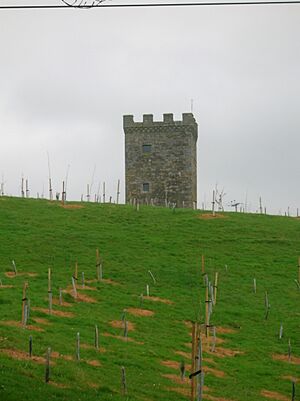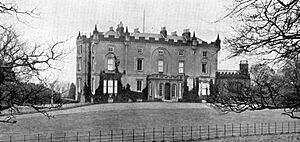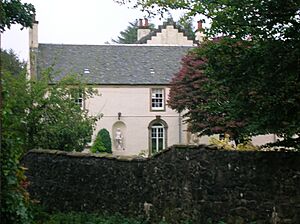Caldwell, East Renfrewshire facts for kids
Caldwell is a grand old house and estate with the remains of a castle nearby. These lands are located near the Lugton Water and the villages of Uplawmoor in East Renfrewshire and Lugton in East Ayrshire.
Contents
Caldwell Castle: A Historic Tower
The Caldwell Tower (NS 4223 5512) stands on a small hill. It's a small tower, probably built in the 1500s. It might be the only part left of a bigger castle. The tower has three floors and a top section with battlements, which look like they've been fixed up over time.
The main door is on the west side. It leads to a basement with a curved ceiling, but you can't get to the upper floors from there. The first floor also has a curved ceiling and is reached by a modern outdoor staircase. The windows are small, and you can still see places where old gun-loops were built into the walls.
In 1775, a map showed the tower as a 'pigeon house' or 'doocot', meaning it was used to keep pigeons. Later, in 1832, another map called it 'Bacon H.', suggesting it was used for curing hams.
In 2011, the tower was restored and turned into a home. This restoration was even shown on the TV series The Restoration Man.
The Mure Family and Caldwell Estate
The Mure Family History
The Caldwell estate has been around for a long time. In 1294, its borders were next to the Steward's forest of Fereneze. The Mure family became owners of Caldwell through marriage in the 1300s. Their family's oldest home was Polkelly Castle, near Kilmarnock.
When King David II was captured in battle, Sir William Mure of Caldwell helped negotiate his release. He was even held as a hostage until the king's ransom was fully paid.
The Mure family was also connected to Oliver Cromwell, a very important figure in English history, through marriage.
Colonel William Mure, who was the laird (landowner) in the early 1900s, was married to Lady Georgiana Montgomerie. She was the eldest daughter of the Earl of Eglinton and Winton. Their son, William Alexander Mure, was born at Eglinton Castle in 1912. He was the last Mure family member to be born in Scotland.
The Mure family's burial place is in Neilston church. Only those directly in line to inherit the estate were buried there.
Caldwell Mansion Houses
The original Caldwell Castle was on a hill southwest of Lochlibo. Only one tower remained after the time of the Covenanters, and that's the tower we see today. A new mansion was built around 1712 by William Mure. However, the current grand house was designed by the famous architect Robert Adam. It was built by William Mure's son, William 'Baron Mure', about 200 yards from the first new house. Caldwell House is a very important example of early castle-style homes in Scotland. It is now a protected historic building.
In 1799, a new garden was made behind the stables. The old house was even turned into stables!
Caldwell House was the Mure family home until 1909. At that time, Colonel Mure found it too expensive to run. He moved his family to the Hall of Caldwell and leased out the mansion.
In 1923, the estate, including the mansion and 280 acres of land, was sold for £7,500. In 1927, the building was turned into a hospital and later a children's home. It operated until 1985. Changes were made to the house, like removing the main staircase for a lift. In 1995, a serious fire damaged the inside and destroyed most of the roof. The building has been on a list of "Buildings at Risk" for many years. Efforts to restore it began in 2006.
The Caldwell Estate Lands
The area in front of Caldwell House was called 'Blackstands Meadow'. Other parts of the estate had interesting names like 'Bells Bog', 'Melons Wood', and 'Ram's Head'. A large garden center is now located at 'Horner's Corner'.
The Saugh Avenue (Saugh means Willow in Scots) runs from behind Caldwell House, crosses the Lugton Water, and joins a main road. This was the main entrance to the estate in the 1820s.
The Mure family also owned lands called 'Blackston'. Nether Ramshead was a Mure property from early times, recorded in 1617.
| What's in a Name? |
| The name Caldwell comes from Keld, meaning a spring or well, and Well. So it means 'The Well in the Wood.' This might refer to the old well on the estate, known as the 'Brandy Well.' |
Sir William Cunninghame of Cunninghamhead had a daughter, Barbara, who married William Mure of Caldwell. She faced difficulties because of her Presbyterian beliefs during a tough time in history.
Duniflett, now called Duniflatt, was part of the estate from 1604 until at least the 1880s.
A Raid on Glasgow's Bishop's Castle
In 1515, John Mure, the Laird of Caldwell, attacked and took over Glasgow's Bishop's Castle. He took many valuable items from the bishop. This happened during the early days of the Scottish Reformation, a time when people were questioning the power of the church. John Mure was found guilty and had to pay for what he took.
The Covenanters and Pentland Rising
In 1666, a group called the Covenanters started an armed uprising. William Mure of Caldwell was the leader of about fifty people who wanted to join them. However, they were stopped by the King's soldiers. Even though William helped the King's troops, he lost his lands. The Mure family got their property back after King James VII was overthrown in 1688.
Hall of Caldwell
This property (Map ref: NS 4141 5504) is about 1.5 miles west of Uplawmoor. It's on the B775 Gleniffer Road. It was also known as Little Caldwell or Wester Caldwell. It's located in the small village or farm area of Hall, next to Hall Farm.
In the 1600s, the 'Guidman of that Ilk' from Hall of Caldwell was a Member of the Scottish Parliament. This title meant someone who held land from a Laird. The Laird would send the tenant of the Hall of Caldwell to Parliament and pay their expenses. A map from 1596 shows a tower house here. This tower house later became a hall house. The hall on the first floor is now divided into two rooms.
In 1909, Colonel Mure added a large, modern extension to the hall. In 1927, more additions and changes were made, including a new garden wall. The Hall of Caldwell is a protected historic building. An archway at the walled garden has the date 1684 on it.
Before the time of the Covenanters, the open green in front of the old Hall of Caldwell was a popular spot for dance gatherings on summer Sunday evenings. People would come from nearby towns like Neilston, Lochwinnoch, and Beith to join in.
Views of Hall Hamlet - 2008
Interesting Facts About the Area
A local story says that an underground passage ran from Caldwell House to the old Lugton Inn (which is now gone). However, owners who searched the cellars didn't find any signs of a secret passage.
Like many other landowners, the Mure family had a townhouse in Irvine.
Mr. Mure of Caldwell attended the Eglinton Tournament in 1839, a famous medieval-style festival.
A train station called Caldwell used to exist near Uplawmoor. It opened in 1871. It was renamed Uplawmoor in 1962. In 1966, the station was temporarily renamed 'Tannochbrae' and decorated to look old-fashioned for a day. This was for filming an episode of the TV show Dr Finlay's Casebook.
The Lochlibo Road runs through the valley. This was an old turnpike road, completed in 1820. It connected Glasgow to Kilmarnock, Irvine, and Ayr.
The ten-acre Halket Loch once lay near the old toll road.
The small village of Shillford is on the Lochlibo Road near Uplawmoor. This settlement grew up around the old toll booth on the road from Irvine to Glasgow.












